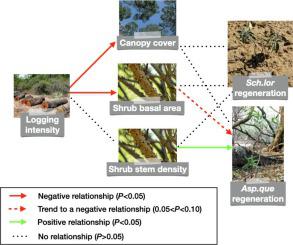当前位置:
X-MOL 学术
›
Forest Ecol. Manag.
›
论文详情
Our official English website, www.x-mol.net, welcomes your feedback! (Note: you will need to create a separate account there.)
Direct and indirect relationships between logging intensity and regeneration of two timber species in the Dry Chaco of Argentina
Forest Ecology and Management ( IF 3.7 ) Pub Date : 2020-10-01 , DOI: 10.1016/j.foreco.2020.118343 Andrés Tálamo , Javier Lopez de Casenave , Lucas A. Garibaldi , Mauricio Núñez-Regueiro
Forest Ecology and Management ( IF 3.7 ) Pub Date : 2020-10-01 , DOI: 10.1016/j.foreco.2020.118343 Andrés Tálamo , Javier Lopez de Casenave , Lucas A. Garibaldi , Mauricio Núñez-Regueiro

|
Abstract Dry forests with a high abundance of hardwood tree species, such as the Dry Chaco, have a long history of logging practices. Logging intensity can directly affect forest structure, both in the canopy and in the understory, by extracting larger trees, and by damaging the understory. This in turn can impact the regeneration of timber species, showing an indirect effect of logging. However, little is known about these relationships in Neotropical dry forests. In this observational study across 13 sites with different logging histories, we analyze how understory structure (shrub basal area and shrub stem density) and canopy cover are modified by logging intensity (quantified by an index that combines logging selectivity, frequency, and time since the last harvest). In addition, using structural equation models, we evaluate if the regeneration (sapling density) of the two most valuable timber species (Schinopsis lorentzii and Aspidosperma quebracho-blanco) is indirectly related with logging intensity through the modification of the structure of the canopy and the understory. We found that canopy cover and shrub basal area decreased with logging intensity (P = 0.001 and P = 0.016, respectively), while shrub stem density showed no changes (P = 0.48). The density of A. quebracho-blanco saplings was positively related with shrub stem density (P = 0.0033), and tended to be negatively related with shrub basal area (P = 0.09). Therefore, the indirect effect of logging intensity on A. quebracho-blanco regeneration, by modifying the shrub basal area, tended to be positive, although the magnitude was quite low. None of the variables considered showed a relationship with regeneration of S. lorentzii. Our results indicate that logging intensity does not negatively affect regeneration of key tree species of the Dry Chaco, nor the density of shrubs. Moreover, shrub basal area and canopy cover may recuperate after a considerable rest period since the last logging event. Together, these results suggest that woody plants in the Dry Chaco forest might be resilient to forestry practices. We propose that logged dry forests must rest decades to recover their structure in canopy cover and shrub basal area. Including other attributes (e.g. soil, fauna and interactions) is necessary to better understand the possible influence of logging intensity on the ecological integrity and sustainability of dry woodlands like Chaco forests.
中文翻译:

阿根廷干查科地区两种木材的采伐强度与再生之间的直接和间接关系
摘要 拥有大量硬木树种的干燥森林,例如干查科,有着悠久的采伐历史。采伐强度可以通过砍伐较大的树木和破坏林下林直接影响林冠和林下的森林结构。这反过来又会影响木材物种的再生,显示出采伐的间接影响。然而,人们对新热带干旱森林中的这些关系知之甚少。在这项跨越 13 个具有不同测井历史的地点的观察性研究中,我们分析了林下结构(灌木基部面积和灌木茎密度)和冠层盖度如何被测井强度(通过结合测井选择性、频率和时间的指数量化)。最后一次收获)。此外,利用结构方程模型,我们评估了两种最有价值的木材物种(Schinopsis lorentzii 和 Aspidosperma quebracho-blanco)的再生(树苗密度)是否通过改变树冠和林下的结构与采伐强度间接相关。我们发现冠层盖度和灌木基部面积随着测井强度的增加而减少(分别为 P = 0.001 和 P = 0.016),而灌木茎密度没有变化(P = 0.48)。A. quebracho-blanco树苗密度与灌木茎密度呈正相关(P = 0.0033),与灌木基部面积呈负相关(P = 0.09)。因此,通过改变灌木基部面积,测井强度对 A. quebracho-blanco 再生的间接影响趋于正,尽管幅度很小。所考虑的变量均未显示与 S. lorentzii 的再生有关。我们的结果表明,伐木强度不会对干查科主要树种的再生产生负面影响,也不会对灌木的密度产生负面影响。此外,灌木基部面积和冠层覆盖可能会在自上次伐木事件后经过相当长的休息期后恢复。总之,这些结果表明干查科森林中的木本植物可能对林业实践具有弹性。我们建议砍伐的干燥森林必须休息几十年才能恢复其冠层和灌木基底区的结构。包括其他属性(例如土壤、动物群和相互作用)对于更好地了解伐木强度对查科森林等干旱林地的生态完整性和可持续性可能产生的影响是必要的。我们的结果表明,伐木强度不会对干查科主要树种的再生产生负面影响,也不会对灌木的密度产生负面影响。此外,灌木基部面积和冠层覆盖可能会在自上次伐木事件后经过相当长的休息期后恢复。总之,这些结果表明干查科森林中的木本植物可能对林业实践具有弹性。我们建议砍伐的干燥森林必须休息几十年才能恢复其冠层和灌木基底区的结构。包括其他属性(例如土壤、动物群和相互作用)对于更好地了解采伐强度对查科森林等干旱林地的生态完整性和可持续性可能产生的影响是必要的。我们的结果表明,伐木强度不会对干查科主要树种的再生产生负面影响,也不会对灌木的密度产生负面影响。此外,灌木基部面积和冠层覆盖可能会在自上次伐木事件后经过相当长的休息期后恢复。总之,这些结果表明干查科森林中的木本植物可能对林业实践具有弹性。我们建议砍伐的干燥森林必须休息几十年才能恢复其冠层和灌木基底区的结构。包括其他属性(例如土壤、动物群和相互作用)对于更好地了解伐木强度对查科森林等干旱林地的生态完整性和可持续性可能产生的影响是必要的。也没有灌木的密度。此外,灌木基部面积和冠层覆盖可能会在自上次伐木事件后经过相当长的休息期后恢复。总之,这些结果表明干查科森林中的木本植物可能对林业实践具有弹性。我们建议砍伐的干燥森林必须休息几十年才能恢复其冠层和灌木基底区的结构。包括其他属性(例如土壤、动物群和相互作用)对于更好地了解伐木强度对查科森林等干旱林地的生态完整性和可持续性可能产生的影响是必要的。也没有灌木的密度。此外,灌木基部面积和冠层覆盖可能会在自上次伐木事件后经过相当长的休息期后恢复。总之,这些结果表明干查科森林中的木本植物可能对林业实践具有弹性。我们建议砍伐的干燥森林必须休息几十年才能恢复其冠层和灌木基底区的结构。包括其他属性(例如土壤、动物群和相互作用)对于更好地了解伐木强度对查科森林等干旱林地的生态完整性和可持续性可能产生的影响是必要的。我们建议砍伐的干燥森林必须休息几十年才能恢复其冠层和灌木基底区的结构。包括其他属性(例如土壤、动物群和相互作用)对于更好地了解伐木强度对查科森林等干旱林地的生态完整性和可持续性可能产生的影响是必要的。我们建议砍伐的干燥森林必须休息几十年才能恢复其冠层和灌木基底区的结构。包括其他属性(例如土壤、动物群和相互作用)对于更好地了解伐木强度对查科森林等干旱林地的生态完整性和可持续性可能产生的影响是必要的。
更新日期:2020-10-01
中文翻译:

阿根廷干查科地区两种木材的采伐强度与再生之间的直接和间接关系
摘要 拥有大量硬木树种的干燥森林,例如干查科,有着悠久的采伐历史。采伐强度可以通过砍伐较大的树木和破坏林下林直接影响林冠和林下的森林结构。这反过来又会影响木材物种的再生,显示出采伐的间接影响。然而,人们对新热带干旱森林中的这些关系知之甚少。在这项跨越 13 个具有不同测井历史的地点的观察性研究中,我们分析了林下结构(灌木基部面积和灌木茎密度)和冠层盖度如何被测井强度(通过结合测井选择性、频率和时间的指数量化)。最后一次收获)。此外,利用结构方程模型,我们评估了两种最有价值的木材物种(Schinopsis lorentzii 和 Aspidosperma quebracho-blanco)的再生(树苗密度)是否通过改变树冠和林下的结构与采伐强度间接相关。我们发现冠层盖度和灌木基部面积随着测井强度的增加而减少(分别为 P = 0.001 和 P = 0.016),而灌木茎密度没有变化(P = 0.48)。A. quebracho-blanco树苗密度与灌木茎密度呈正相关(P = 0.0033),与灌木基部面积呈负相关(P = 0.09)。因此,通过改变灌木基部面积,测井强度对 A. quebracho-blanco 再生的间接影响趋于正,尽管幅度很小。所考虑的变量均未显示与 S. lorentzii 的再生有关。我们的结果表明,伐木强度不会对干查科主要树种的再生产生负面影响,也不会对灌木的密度产生负面影响。此外,灌木基部面积和冠层覆盖可能会在自上次伐木事件后经过相当长的休息期后恢复。总之,这些结果表明干查科森林中的木本植物可能对林业实践具有弹性。我们建议砍伐的干燥森林必须休息几十年才能恢复其冠层和灌木基底区的结构。包括其他属性(例如土壤、动物群和相互作用)对于更好地了解伐木强度对查科森林等干旱林地的生态完整性和可持续性可能产生的影响是必要的。我们的结果表明,伐木强度不会对干查科主要树种的再生产生负面影响,也不会对灌木的密度产生负面影响。此外,灌木基部面积和冠层覆盖可能会在自上次伐木事件后经过相当长的休息期后恢复。总之,这些结果表明干查科森林中的木本植物可能对林业实践具有弹性。我们建议砍伐的干燥森林必须休息几十年才能恢复其冠层和灌木基底区的结构。包括其他属性(例如土壤、动物群和相互作用)对于更好地了解采伐强度对查科森林等干旱林地的生态完整性和可持续性可能产生的影响是必要的。我们的结果表明,伐木强度不会对干查科主要树种的再生产生负面影响,也不会对灌木的密度产生负面影响。此外,灌木基部面积和冠层覆盖可能会在自上次伐木事件后经过相当长的休息期后恢复。总之,这些结果表明干查科森林中的木本植物可能对林业实践具有弹性。我们建议砍伐的干燥森林必须休息几十年才能恢复其冠层和灌木基底区的结构。包括其他属性(例如土壤、动物群和相互作用)对于更好地了解伐木强度对查科森林等干旱林地的生态完整性和可持续性可能产生的影响是必要的。也没有灌木的密度。此外,灌木基部面积和冠层覆盖可能会在自上次伐木事件后经过相当长的休息期后恢复。总之,这些结果表明干查科森林中的木本植物可能对林业实践具有弹性。我们建议砍伐的干燥森林必须休息几十年才能恢复其冠层和灌木基底区的结构。包括其他属性(例如土壤、动物群和相互作用)对于更好地了解伐木强度对查科森林等干旱林地的生态完整性和可持续性可能产生的影响是必要的。也没有灌木的密度。此外,灌木基部面积和冠层覆盖可能会在自上次伐木事件后经过相当长的休息期后恢复。总之,这些结果表明干查科森林中的木本植物可能对林业实践具有弹性。我们建议砍伐的干燥森林必须休息几十年才能恢复其冠层和灌木基底区的结构。包括其他属性(例如土壤、动物群和相互作用)对于更好地了解伐木强度对查科森林等干旱林地的生态完整性和可持续性可能产生的影响是必要的。我们建议砍伐的干燥森林必须休息几十年才能恢复其冠层和灌木基底区的结构。包括其他属性(例如土壤、动物群和相互作用)对于更好地了解伐木强度对查科森林等干旱林地的生态完整性和可持续性可能产生的影响是必要的。我们建议砍伐的干燥森林必须休息几十年才能恢复其冠层和灌木基底区的结构。包括其他属性(例如土壤、动物群和相互作用)对于更好地了解伐木强度对查科森林等干旱林地的生态完整性和可持续性可能产生的影响是必要的。



























 京公网安备 11010802027423号
京公网安备 11010802027423号